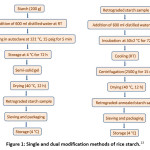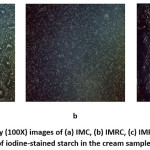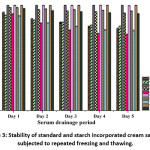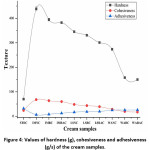Introduction
The modern food market is flooded with food choices containing ingredients of different origins and physiological pathways. Consumption of high calorie and excessively processed foods has been often associated with escalations of lifestyle disorders. Fat is generally considered as one of the major food component that imparts to the sensory and physiological properties like texture, flavor, reliability and mouth-feel to foods.1 However, consumption of high amount of dietary fat is associated with several health disorders like obesity, cardiovascular diseases and hypertension. Considering the global need for health food alternatives, in the recent years, food scientists and technologists have been focusing on development of food products conveying positive health benefits to the consumers.
Whipping cream is a well-known dairy-based product, generally used as primary ingredient in ice-cream and as bakery toppings and fillers. It is an oil-in-water emulsion, developed by introduction of air bubbles and aggregation of fat globules generating air bubble-fat globule interlaced network, forming the cream harder eventually.2 Its popularity has encouraged the dairy industries for production, resulting in availability of a number of commercial whipped cream variants in the market. However, developing low-fat alternatives of such fat-rich food products is a challenge. The term ‘fat replacer’ is used for ingredients which can be used to partially or completely replace fats in products. They have accelerated the advancement of fat shorten and fat free foods. Fat replacers are classified as protein-based, carbohydrate-based and cellulose-based and used in variety of formulations like sour cream, cheese, frozen dessert, salad dressing and baked goods.3,4 Immoderate use of fat replacers generally increase the stickiness. Usually in different food products, different carbohydrates and other hydrocolloids could be used as texture amplifiers, stabilizers, thickeners as well as gelling agents.5,6 Polysaccharides in the food products are mostly considered to be responsible for viscosity and gelling.7 Starch, a potential polysaccharide, discovered a wide range of applications as gelling, glazing, foam-strengthening and antistaling agents as well as stabilizers, texturizers, thickeners, binders and film formation.8,9 Studies demonstrated that the multipurpose nature of rice starches welfares both food as well as non-food industries.10 Raw and modified starches have been successfully used as fat replacer and fat mimetic in high fat semisolid foods, resulting in more than 50% fat reduction in the products.1,11,12,13 As fat mimetic, starch does not replace fat molecule on weight-for-weight basis but may imitate some of the physical and organoleptic properties of the standard fat it is replacing. Rice (Oryza sativa L.) is a rich source of starch. Some of the exclusive characteristics of rice starches like bland taste, creamy, smooth, glossy and spreadable texture in its gelatinized or pregelatinized-reconstituted forms make them suitable for use in different food products. Being one of the smallest in size (2-10 µm) rice starch granules are easy to modify and may give texture perception similar to that of fat, although having lower glycemic index.14,15 Considering the necessity of soft, smooth gel in pastry making, rice starch could serve as an effective fat substitute.16 Lowering of fat percentage by the use of fat replacers should not affect the sensorial properties of the foods.
Starches are modified using physical, chemical or enzymatic techniques to bring about necessary changes in their properties targeting specific applications.17 Physical starch modification techniques generally involving thermal process treatments are considered as safe as they do not involve use or liberation of any hazardous molecule. In a previous study, for the first time, starch extracted from three rice varieties, namely Mushkbudij, SR1 and Aghoni bora with 22.7 %, 9.8 % and 0.3 % apparent amylose content were modified by single retrogradation and dual retrogradation-annealing modification techniques (Fig 1). The dual modified starches were found to have improved crystallinity, enzyme-resistant starch fractions and thermo-stability.18 The study concluded enhanced thermostability, enzyme resistance and functional properties in the modified starches and suggested their suitable targeting for food and non-food applications. In this study, both the raw and modified starches of each rice variety were applied for partially replacing fats in whipped cream and compared with standard cream samples for whipping characteristics, stability and texture.
 |
Figure 1: Single and dual modification methods of rice starch.13 Click here to View figure |
Materials and Methods
Materials
Previously isolated and modified native, retrograded and retrograded-annealed rice starch samples coded as per the modification treatment types (Table 1) were stored in a refrigerator (5ºC) until use.18 Darigold, a 40 % fat containing heavy whipping cream was procured from the local market.
Table 1: Rice varieties, starch sample codes and cream sample codes
| Rice Variety | Modification type | Starch code | Cream code | |
| Single, retrograded | Double, retrograded-annealed | |||
| – | – | IMN | IMNC | |
| Mushkbudij | ü | – | IMR | IMRC |
| ü | ü | IMRA | IMRAC | |
| – | – | LSN | LSNC | |
| SR1 | ü | – | LSR | LSRC |
| ü | ü | LSRA | LSRAC | |
| – | – | WAN | WANC | |
| Aghoni bora | ü | WAR | WARC | |
| ü | ü | WARA | WARAC | |
| – | – | – | – | STDC |
Whipping Cream Samples Preparation
Commercial whippable cream (Darigold, 40% fat) was used as standard (STDC). To produce fat-replaced whipping cream, the fat content of a fresh cream (25.6% fat, db) was first adjusted to 15% by adding skim milk (1.1% fat). Dilution allowed better dispersion of added solutes. The cream was pasteurized at 85 °C for 5 minutes and cooled to room temperature (25±2 °C). 10 g of starch sample was then added to 100g of the pasteurized diluted cream and thoroughly mixed with a blender (Philips) rotating at 3000 rpm for 1 minute. The cream was refrigerated at 5 °C for 24 h to promote stabilization. These samples were coded as IMNC, IMRC, IMRAC, LSNC, LSRC, LSRAC, WANC, WARC and WARAC (Table 1).
Fat Content
Fat content was determined according to the method described in AOAC (2000).19 Nine milliliters of sodium chloride (0.5% w/v) solution was added to 1 g of whipped cream taken in a 50 ml beaker. To this dispersion, 1ml of concentrated ammonia was added and mixed properly. After that, 10 ml of ethyl alcohol was added and mixed thoroughly. Then, 25 ml of diethyl ether was added and shaked vigorously for 1 min followed by addition of 25 ml of petroleum ether, again with vigorous shaking for about half min. The mixture was then allowed to stand until the upper layer separated and cleared completely. The clear supernatant ether solution containing the fat was then transferred into a conical flask. The extraction procedure was repeated thrice, the obtained supernatant solution was added to the conical flask. The supernatant was dried in hot air oven at 100 ± 2°C until constant weight was obtained. The flask was placed in a desiccator and the fat percentage was determined by the equation
Fat % (w/w) = Weight of Extracted Fat/Weight of whipped cream ´ 100 (1)
Light microscopy
Homogenized cream sample was carefully mounted on glass slides, stained with iodine and viewed at 100X magnification to study the distribution of starch within the cream matrices.
Whipping time and overrun
Whipping time was calculated as the time for attaining maximum overrun after repeated whipping trials using a hand held whipper (OHM-207, ORPAT) at maximum speed. Overrun is the volume of air incorporated and retained in cream after whipping. Overrun value was measured after 10 s of whipping time as the foam tends to collapse after attaining the maximum volume and expressed as percentage.20
Overrun % = [(Vw – Vuw) / Vuw]´ 100 (2)
Where,
Vw = Volume of whipped cream (ml)
Vuw = Volume of unwhipped cream (ml)
Viscosity
Viscosity of the whipped cream samples incorporated with raw, single-modified and dual-modified starches were determined using a viscometer (HAAKETM ViscotesterTM C, Thermo Fisher Scientific, USA) equipped with a helipath and a LV spindle (L3) rotating at a speed of 20 rpm. Samples were manually adjusted using a spatula in order to obtain a homogeneous suspension for viscosity measurements.
Stability to Temperature Fluctuation
Creams are never thermodynamically stable. Generally, this instability is minimized by the addition of stabilizers. Retention of fat-water interface is important. Whipped cream is used in food products which often experience temperature fluctuation during storage and transportation. Stability of whipped cream was determined as resistance to serum loss during freezing and thawing. For this, 10 g of freshly whipped cream whipped to its whipping time was filled and leveled in a Buchner funnel, covered with aluminum foil and placed over a 25 ml measuring cylinder. Five repeated freeze-thaw cycles were performed by freezing the set up at -16°C for 18 h followed by thawing at 25 °C for 5 h. Liquid serum collected in the measuring cylinder was weighed and corresponding weight of thawed cream was calculated to determine the percentage stability using the formula
% Stability = [(Wtc – Wwc)] ´ 100 (3)
Where,
Wtc = Weight of thawed cream
Wwc = Weight of freshly whipped cream
Color
A CIE color measuring instrument (Ultrascan Vis, Hunter Lab, USA) was used to evaluate the L*, a* and b* color parameters, representing lightness to darkness, redness to greenness and yellowness to blueness values of the samples, respectively.
Texture Analysis
A back extrusion test was carried out at room temperature (25±2°C) to measure the texture parameters, namely hardness, adhesiveness and cohesiveness of unwhipped cream samples. The texture analyzer was fitted with a 5 Kg load cell and a plunger-shaped probe of 40 mm diameter. Test was performed at the rate of 1 mm/s with a penetration distance of 33 mm into the cream sample and back. The maximum stress value gave hardness (g), negative area of the graph gave adhesiveness (g/s) and the ratio of areas under the two peaks gave cohesiveness.
Statistical Analysis
Experiments were carried out in triplicates and mean values were reported. Tests of significant differences between the mean values were analyzed by Duncan’s multiple range tests at a significance level of 95% using SPSS 11.5 software (SPSS Inc., USA).
Results and Discussion
Fat Content
The values of fat content (Table 2) indicated low fat percentage (approximately 15%) of all cream samples containing starch, indicating about 62.5% lower fat content than the standard cream sample.
Light Microscopy
Iodine specifically binds to amylose to give a blue-colored complex. Amylopectin gives a brownish color.9,21 Upon observation under light microscope, it was observed that dispersion of starch phase was the most uniform in cream samples containing retrograded starches followed by the dual modified and native starch incorporated creams (Fig. 2). Retrograded starch is mostly amorphous, smooth and readily dispersive upon mixing.22 Sufficient mixing resulted in more uniform distribution of the retrograded starch in the cream mass. Annealing causes crystalline nucleation and subsequent granulation, which could be attributed to comparatively lower dispersibility than retrograded starch.24,25
 |
Figure 2: Light microscopy (100X) images of (a) IMC, (b) IMRC, (c) IMRAC, showing distribution of iodine-stained starch in the cream samples Click here to View figure |
Whipping Time
Creams incorporated with dual modified rice starches showed lower whipping time than cream samples with single modified and native starches (Table 2). Lower whipping time of IMRAC and LSRAC than STDC could be attributed to lower cohesiveness of mechanically more stable dual modified starches in the cream solution.26 Incorporation of native as well as modified waxy rice starches resulted in the longest whipping times. Higher flowability resulting from their addition could have resulted in inefficient whipping of the incorporated creams.
Overrun
Overrun values of whipped creams indicate the capacity of air incorporation in it. At maximum overrun, all the air bubbles in the foam are encapsulated by coalesced fat droplets adsorbed at the air-serum interface.27 High concentration of fat could hinder foamability of cream. Starch incorporated whipped creams showed higher overrun than starch-free STDC (Table 2). It could be opined that addition of starch in cream resulted in increased viscosity and enhanced stability, which led to the higher entrapment of air. Denser, viscous liquids are more efficient in trapping air than thinner liquids.20,27 Therefore, the difference in overrun of whipped creams with all native, single and dual modified rice starches owed to improved viscosities of the creams.
Viscosity
The values of viscosity of standard whipping cream and the whipping cream incorporated with native and dual modified starch are presented in Table 2. All the samples blended with native and modified starches for whipping cream preparation showed higher viscosity than standard whipping cream STDC. The increase in viscosity was attributed to the retention of water molecules by the starch granules, resulted in the decreased fluidity and increased resistance to flow.28 Among the starch incorporated whipping cream samples, the viscosity was found to be the highest in the IMNC followed by LSNC, IMRC and WANC. The highest viscosity presented by IMNC was accredited to better hydrating capacity of the incorporated starch. The viscosity alters the overall body structure and texture of whipping cream mixes which in turn depends on type and concentration of starch.20
Table 2: Overrun, whipping time and lightness (L*), redness (a*), yellowness (b*) color values of whipped cream samples.
| Sample coding | STDC | IMNC | IMRC | IMRAC | LSNC | LSRC | LSRAC | WANC | WARC | WARAC | |
| Fat (%) | 40 ± 2b | 15 ± 0.7a | 15 ± 1ab | 15 ± 0.5a | 15 ± 0.5a | 15 ± 0.9a | 15 ± 1ab | 15 ± 0.5a | 15 ± 0.5a | 15 ± 1ab | |
| Whipping time (s) | 90 ± 1.20c | 160 ± 2.26f | 150 ± 2.40e | 60 ± 1.72a | 210 ± 4.17h | 120 ± 2.32d | 70 ± 1.63b | 390 ± 1.18i | 420 ± 1.41j | 180 ± 1.45g | |
| % Overrun (%) | 30.02 ± 1.51a | 44.04 ± 1.12def | 40.00 ± 1.15cde | 32.01 ± 1.32ab | 44.08 ± 1.59f | 39.52 ± 1.67def | 34.00 ± 1.11abc | 45.00 ± 1.23ef | 38.02 ± 1.11bcd | 34.08 ± 1.84abc | |
| Viscosity (cP) | 4456.8 ± 43.5e | 7543.4 ± 51.1g | 5436.3 ± 42.3e | 4986.5 ± 39.8d | 6635.8 ± 45.9f | 5198.6 ± 47.7f | 4787.2 ± 24.9a | 5434.1 ± 32.6b | 5054.7 ± 47.3f | 4670.5 ± 34.5c | |
| Color | *L | 85.43 ± 1.59a | 87.22 ± 1.45a | 87.00 ± 2.11a | 86.54 ± 1.48a | 86.55 ± 1.04a | 87.01 ± 1.13a | 86.59 ± 1.07a | 86.48 ± 1.08a | 86.90 ± 1.67a | 86.02 ± 1.62a |
| *a | -2.00 ± 0.02a | -2.37 ± 0.31b | -2.39 ± 0.12b | -1.99 ± 0.05a | -2.26 ± 0.02b | -2.31 ± 0.01b | -1.97 ± 0.04a | -2.41 ± 0.01b | -2.40 ± 0.01b | -2.98 ± 0.03c | |
| *b | 8.97 ± 0.12a | 8.23 ± 0.15c | 8.72 ± 0.13d | 7.97 ± 0.20b | 8.10 ± 0.16bc | 8.02 ± 0.01bc | 7.61 ± 0.11a | 8.00 ± 0.05bc | 8.01 ± 0.18bc | 7.72 ± 0.04e | |
aMeans followed by the same superscripted letter in a row do not differ significantly from one another (P > 0.05)
Stability to Temperature Fluctuation
Whipped creams prepared with native starch samples showed lower stability than creams incorporated with modified starches. IMRC, LSRC and WARC showed no syneresis during the five freeze-thaw cycles (Fig. 3). Amorphous fractions in retrograded starch have a tendency to entrap and hold water.23 However, dual modified starch incorporated IMRAC, LSRAC and WARAC creams showed initial drop in stability indicated by excessive serum release (1.5 ml, 2.3 ml and 2.8 ml, respectively). Clustering of some amorphous fractions of the starch into crystalline domains during annealing could be attributed to this.24,25 Significantly lower serum loss during the last four freeze-thaw cycles generated average values indicating better stability than single modified starch incorporated creams. Overall, the results indicated that both native and modified rice starches improve cream stability to different extents and can be suitably used as stabilizers.
 |
Figure 3: Stability of standard and starch incorporated cream samples subjected to repeated freezing and thawing. Click here to View figure |
Color
No significant difference in the L*, a* and b* values were observed in the starch incorporated cream samples (Table 2). The marginally higher L* and lower b* values observed for STDC could be attributed to partial replacement of fat with starch in the fat replaced cream samples.29
Texture Analysis
Incorporation of native and modified starches resulted in significant differences in cream texture (Fig. 4). Hardness value increased after addition of starch. Native starch incorporated samples, namely IMNC and LSNC gave the highest values of 438.6 g and 347.5 g respectively. Single modified retrograded starches with higher dispersibility and tendency for intermolecular binding resulted in harder cream than dual modified starch incorporated creams. Single and dual modification resulted in increased leachable fractions in all the three rice starches, resulting in increased adhesiveness of the starch incorporated creams.30 WARC and WARAC showed high adhesiveness (36.1 g/s and 36.8g/s respectively) and low cohesiveness (27.4 and 26.8 respectively) values, which were closest to the adhesiveness (150.4 g/s) and cohesiveness (147.8) values of STDC.
 |
Figure 4: Values of hardness (g), cohesiveness and adhesiveness (g/s) of the cream samples. Click here to View figure |
Conclusion
On incorporating raw and modified IM and LS starches in cream, improved whippability and foam stability were attained. Although modified waxy WA starches gave a cream texture similar to the standard commercial cream sample, poorer whippability was a major limitation. Both single and dual modified rice starches can be effectively used as fat replacer in creams with added stabilizing properties. Fat replacement with retrograded-annealed samples could provide thermostable alternative with controlled glucose release benefits in whipping creams. The study creates scope for further inspection of the bonding patterns to understand the exact mechanism by which the modified starches get better distributed in the native cream to replace the fat component. A sensory acceptability test amongst regular whipping cream users and a market feasibility study would be further necessary for commercialization of the product.
Acknowledgment
The authors are thankful to Prof V K Modi, Head, Amity Institute of Food Technology for providing support and facilities to carry out the experimental works of this research.
Funding
The author(s) received no financial support for the research, authorship, and/or publication of this article.
Conflict of Interest
The authors do not have any conflict of interest with any person or organization in publishing this article.
References
- Thaiudom S., Khantarat K. Stability and rheological properties of fat-reduced mayonnaises by using sodium octenyl succinate starch as fat replacer. Procedia Food Science. 2011; 1: 315-321.
- Ihara et al. Influence of whipping temperature on the whipping properties and rheological characteristics of whipped cream. Journal of Dairy Science. 2010; 93: 2887-2895.
- Swanson B. G. Fat Replacers. 2003; 2284-2287.
- Mela, D. Food, diet and obesity. 2005. Elsevier.
- Peng X., Yao, Y. Carbohydrates as fat replacers. Annual Review of Food Science and Technology. 2017; 8: 331-351.
- Imeson A. Food stabilisers, thickeners and gelling agents. 2011. John Wiley & Sons.
- Hemar Y., Tamehana M., Munro P. A., Singh H. Influence of xanthan gum on the formation and stability of sodium caseinate oil-in-water emulsions. Food Hydrocolloids. 2001; 15: 513-519.
- Alcázar-Alay S. C., Meireles, M. A. A. Physicochemical Properties, Modifications and Applications of Starches from different Botanical Sources. Food Science and Technology. 2015; 35: 215-236.
- BeMiller J. N. Carbohydrate Chemistry for Food Scientists. 2018. Elsevier.
- Yazid N. S. M., Abdullah N., Muhammad N., Matias-Peralta H. M. Application of Starch and Starch-Based Products in Food Industry. Journal of Science and Technology. 2018; 10.
- Byars J. Effect of a starch-lipid fat replacer on the rheology of soft-serve ice cream. Journal of Food Science. 2002; 67: 2177-2182.
- Johnson, M. E. Cheese: Preparation of Cheese Milk. 2016.
- Babu, A. S., Parimalavalli, R., Mohan, R. J. Effect of modified starch from sweet potato as a fat replacer on the quality of reduced fat ice creams. Journal of Food Measurement and Characterization. 2018; 12: 2426-2434.
- Champagne E. T. Rice starch composition and characteristics. Cereal Foods World. 1996; 41: 833-838.
- Bagheri F., Radi M., Amiri S. Evaluating the function of cross‐linked rice starch as a fat replacer in low fat cream. International Journal of Dairy Technology. 2018; 71: 981-991.
- Bao J., Bergman C. J. Rice flour and starch functionality. Starch in Food. 2018:373-419. Woodhead Publishing.
- Ashogbon A. O. Current Research Addressing Physical Modification of Starch from Various Botanical Sources. Global Nutrition and Dietetics. 2018; 7: 2.
- Iftikhar S. A., Dutta, H. Status of polymorphism, physicochemical properties and in vitro digestibility of dual retrogradation-annealing modified rice starches. International Journal of Biological Macromolecules. 2019; 132: 330-339.
- Association of official analytical chemists (AOAC): official methods of analysis. 17th ed. Washington, DC. 2000.
- Farahmandfar R., Asnaashari M., Salahi M. R., Rad T. K. Effects of basil seed gum, cress seed gum and quince seed gum on the physical, textural and rheological properties of whipped cream. International Journal of Biological Macromolecules. 2017; 98: 820-828.
- Gott, B., Barton, H., Samuel, D., Torrence, R. Biology of starch. Ancient starch research. 2016:35-46. Routledge.
- Zhu F. Starch based aerogels: Production, properties and applications. Trends in Food Science & Technology. 2019; 89: 1-10
- Wang S., Li C., Copeland L., Niu Q., Wang S. Starch retrogradation: A comprehensive review. Comprehensive Reviews in Food Science and Food Safety, 2015; 14: 568-585.
- Bhattacharjya B., Dutta H., Patwari K., Mahanta C. L. Properties of annealed jackfruit (Artocarpus heterophyllus Lam.) seed starch. Acta Alimentaria. 2015; 44: 501-510.
- Yu K., Wang Y., Xu Y., Guo L., Du X. Correlation between wheat starch annealing conditions and retrogradation during storage. Czech Journal of Food Sciences. 2016; 34: 79-86.
- El-Abd M. M., Salama F. M., Zeidan M. A., Baker E. A. Functional properties of whipped cream as affected by addition of β-lactoglobulin and α-lactalbumin. Journal of Food and Dairy Sciences. 2017; 8: 387-390.
- Rybak O. Milk fat in structure formation of dairy products: a review. Ukrainian Food Journal. 2016; 5: 499-514.
- Sahin H., Ozdemir, F. Effect of some hydrocolloids on the rheological properties of different formulated ketchups. Food Hydrocolloids. 2004; 18: 1015-1022.
- Kaylegian K. E., Hartel R. W., Lindsay R. C. Applications of modified milk fat in food products. Journal of Dairy Science. 1993; 76: 1782-1796.
- Fonseca-Florido H. A., Gómez-Aldapa C. A., Velazquez G., Hernández-Hernández E., Mata-Padilla J. M., Solís-Rosales S. G., Méndez-Montealvo G. Gelling of amaranth and achira starch blends in excess and limited water. LWT-Food Science and Technology. 2017; 81: 265-273.

This work is licensed under a Creative Commons Attribution 4.0 International License.






